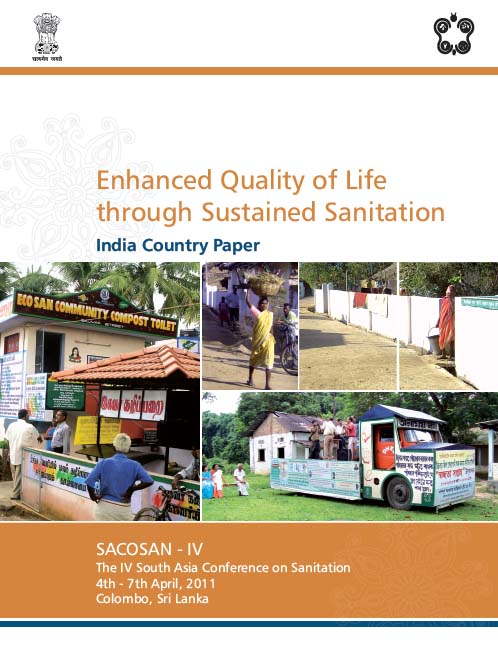/topics/sanitation
Sanitation
Assessment study of impact and sustainability of Nirmal Gram Puraskar A report by CMS Environment
Posted on 22 Nov, 2014 10:30 AMNGP was initiated in Oct 2003 to encourage Panchayati Raj Institutions (PRIs), block and districts to take up sanitation promotion, a post achievement, award-cum-fiscal incentive scheme. The eligibility criteria for the PRIs to receive NGP include: Gram Panchayats, Blocks and Districts, which achieve 100 per cent sanitation coverage in terms of: (1) 100 per cent sanitation coverage of individual households (2) 100 per cent school and anganwadis sanitation coverage (3) Free from open defecation and (4) Clean environment maintenance (liquid and solid waste management).
Enhanced quality of life through sustained sanitation: India country paper for South Asia Conference on Sanitation
Posted on 22 Nov, 2014 10:30 AM This India Country Paper on Enhanced Quality of Life through Sustained Sanitation was prepared for South Asia Conference on Sanitation (SACOSAN) IV held at Colombo, Sri Lanka in April, 2011.
This India Country Paper on Enhanced Quality of Life through Sustained Sanitation was prepared for South Asia Conference on Sanitation (SACOSAN) IV held at Colombo, Sri Lanka in April, 2011.
In rural sanitation, India’s flagship rural sanitation programme, the Total Sanitation Campaign (TSC), continues to be implemented with renewed vigour, and improvements in multiple facets of the programme. The TSC programme was given a further boost with the introduction of the Nirmal Gram Puraskar (NGP), an innovative incentive scheme for Gram Panchayats, Blocks and Districts. The rural sanitation sector has continued to receive increasing budgetary support.
Scaling up rural sanitation Findings from the impact evaluation baseline survey in Madhya Pradesh
Posted on 22 Nov, 2014 10:30 AMThis report is a part of a series of papers that analysed the baseline data from all countries where the program was implemented.
Survey of recent sanitation achievement in Himachal Pradesh A study by Institute of Development Studies
Posted on 22 Nov, 2014 10:30 AMThis report of a study commissioned by the Institute of Development Studies on the Community Led Total Sanitation (CLTS) site presents the findings of the survey that was conducted in Himachal Pradesh to assess the progress made by the state in rural sanitation, in the context of the sanitation revolution, which is said to have occurred in the state of Himachal Pradesh in the last few years.
Himachal Pradesh has a population of about 6.9 million and is over 90% rural. It has a relatively good record on human development indicators and access to public services. However, it showed a dismal awareness on the sanitation front till a few years ago.For example, in 2004, household toilet coverage in rural areas of Himachal Pradesh was estimated at about 28%. In early 2005, the Government of Himachal Pradesh adopted a new strategy to secure better rural sanitation results, which included:
From dreams to reality : Compendium of best practices in rural sanitation in India A document by the Water and Sanitation Programme and the Ministry of Rural Development
Posted on 22 Nov, 2014 10:30 AMThis compendium by the Water and Sanitation Programme and the Ministry of Rural Development, Government of India presents case studies about the achievements and experiences of different situations, institutional models, community mobilisation approaches, supply chain management techniques, capacity building methods, convergence of various programmes, school sanitation, innovative approaches etc from different states and regions in the country.
After a decade of launching the Total Sanitation Campaign, India has seen significant successes in terms of the sanitation coverage, creating open defecation communities/GPs and solid and liquid waste management. Thousands of success stories have emerged across the country while still there are many challenges in making the entire rural India Nirmal and sustaining the changes achieved.
Uttar Pradesh Urban Sanitation Policy Jawaharlal Nehru National Urban Renewal Mission Government of India 2010
Posted on 22 Nov, 2014 10:30 AMThe factors that lead to this poor sanitation situation in the city include:
Capacity and investment in the water supply and sanitation sectors - Guidelines in respect of participation of cooperative institutions 2006 Water Supply and Sanitation Department Government of Maharashtra
Posted on 22 Nov, 2014 10:30 AMIt argues that this is because civil bodies are facing many problems due to urbanisation and increasing demand from the residents. There is a need to increase efficiency in the water supply and sewage.
Monitoring systems for incentive programmes Learning from large scale rural sanitation initiatives in India
Posted on 22 Nov, 2014 10:30 AMDepartment of Drinking Water and Sanitation Information on water and sanitation in India
Posted on 22 Nov, 2014 10:30 AMA huge number of links are present on these sites which provide access to various data and information regarding the status of rural drinking water & sanitation and related government projects.
Study of water supply sanitation practices in India using geographic information systems Some design other considerations in a village setting IJMR research paper
Posted on 22 Nov, 2014 10:30 AMThe study attempted to understand the phenomenon of water contamination in the village by using GIS as a tool to locate and map water supply and sewage distribution systems in the village, in relation to human and animal dwellings, their wastes, sanitary practices and their connections with drinking water quality for a clearer understanding of the connections between these factors and possible





